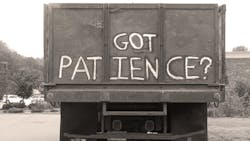The pickup truck sped up close to the bumper of the slow-moving car, then backed off. Speeding up again, it sharply pulled alongside the driver’s door. I could clearly see the pickup driver screaming and gesticulating.
“Foolish and dangerous,” I thought, pulling out on my California Highway Patrol motorcycle, lights flashing and siren on. When the pickup pulled over, I marched to the window, feeling my anger rise about the dangerous maneuver. And then I stopped, paused, and realized I was acting no better than the person driving that pickup truck. I ticketed him, calmly, and reminded myself of the power of self-restraint.
Aggressive driving—road rage—has many triggers. Traffic delays, running late, motorists who dawdle in a passing lane, and drivers who fail to yield the right-of-way, to name a few. All can stoke the anger and self-righteousness of someone who may already feel above the la—and certainly above other drivers on the road.
See also: Tips to safely survive International Roadcheck 2023
Add anonymity to that. As a National Highway Traffic Safety Administration study on aggressive driving put it, “A motor vehicle insulates the driver from the world while, at the same time, traveling through it.”
As a fleet manager, you should be aware that the anonymity of operating a commercial motor vehicle—your truck drivers up there, isolated from the world—can trigger road rage in both directions.
To some passenger car drivers, that truck is inhuman. It is just an enormous machine, occupying too much space on the road, blocking the view of traffic. No wonder some car drivers cut into a truck’s safety zone, the following distance needed for a safe stop. Those motorists feel only their own frustration.
At the same time, the truck driver can feel the temperature rising. “I’ve got a job to do, and these amateurs are keeping me from it,” might be the thought. “Maybe if I just close that gap a bit, the cars won’t cut in front. Maybe if I edge a little closer to his bumper or lay on the horn, that guy will get off his cell phone and drive.”
Fleet managers, of course, always tell their truck drivers that safety comes first. Here, though, is a basic message to combat road rage:
Preventing road rage in trucking: 'Act, don't react'
- Act by maintaining that safe following distance. Don’t react by closing the gap.
- Act by signaling your intent early—turn signals, flashers, headlights. Use your vision high up there in the truck cab to alert motorists who cannot see as well as you do. Don’t react by using your horn to complain about their misguided actions.
- Act by staying away from angry drivers. Don’t react by trying to teach them a lesson.
- Act by showing folks that there is a human driving the truck. Roll down your window and give a friendly wave. Say “hello” in the parking lot. Don’t react by having your truck do the talking.
Most of all, act like I had to remind myself to act when I was a patrolman—calmly. Don’t react by trading frustration for frustration. Everyone loses then, especially safety.
Steve Vaughn is senior vice president of field operations at PrePass Safety Alliance, the provider of PrePass weigh station bypass and electronic toll-payment and management services. Vaughn served nearly three decades with the California Highway Patrol and is a past president of the Commercial Vehicle Safety Alliance.
About the Author
Steve Vaughn
Senior Vice President of Field Operations
Steve Vaughn is senior vice president of field operations at PrePass Safety Alliance, the provider of PrePass weigh station bypass and electronic toll-payment and management services. Vaughn served nearly three decades with the California Highway Patrol and is a past president of the Commercial Vehicle Safety Alliance.
